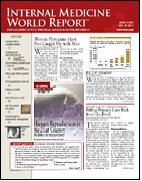Biphasic Insulin Aspart 70/30 Attractive Option When Initiating Insulin Therapy
Biphasic Insulin Aspart 70/30 Attractive Option When Initiating Insulin Therapy
ORLANDO—Biphasic insulin aspart 70/30 (NovoLog Mix 70/30) is a reasonable choice when initiating insulin therapy in patients with insulin-naïve type 2 diabetes who are inadequately controlled with oral antidiabetic agents, researchers reported at the American Diabetes Association (ADA) annual meeting.
Philip Raskin, MD, of the University of Texas Southwestern Medical Center, Dallas, presented results in 209 patients who had been randomized to 1 of 2 insulin initiating regimens: premeal injections of biphasic insulin aspart 70/30 twice daily plus metformin (with/without thiazolidinediones) or a single bedtime injection of insulin glargine (Lantus) plus metformin (with/without thiazolidinediones).
All patients had insulin-naïve type 2 diabetes with Hemoglobulin (HB) A1C ³8%, despite treatment with metformin at least 1000 mg, as a single agent or in combination therapy for at least 3 months.
Results showed that twice-daily biphasic insulin aspart 70/30 used in a simple titration schedule provided a mean HbA1C reduction of 2.8% and allowed 66% of patients to reach the ADA goal of HbA1C <7%.
Biphasic insulin aspart 70/30 also provided significantly greater HbA1C reduction and better postprandial glycemic control than once-daily insulin glargine, and enabled significantly more patients to reach the recommended American College of Endocrinology/International Diabetes Federation HbA1C goal of £6.5% as well as the ADA HbA1C goal.
“This study shows that initiating insulin therapy with a dual-action insulin analog that provides a physiological approach to controlling insulin needs at mealtime and throughout the day provides multiple benefits,” said Dr Raskin.
In the trial, metformin doses were adjusted to1500 mg/d during a 4-week run-in period. Insulin was initiated with 5 to 6 U biphasic insulin aspart 70/30 twice daily or 10 to 12 U glargine at bedtime and then titrated to target blood glucose (80-110 mg/dL). The dose was titrated weekly for the first 12 weeks, then every 2 weeks thereafter.
Dinnertime biphasic insulin aspart 70/30 and bedtime glargine were titrated based on fasting blood glucose over the prior 3 days; morning biphasic insulin aspart 70/30 was titrated based on predinner blood glucose over the previous 3 days.
After 28 weeks, 66% of patients taking biphasic insulin apart 70/30 reached target HbA1C levels of <7% compared with 40% of patients taking insulin glargine (P = .0002). Overall, 42% of patients in the biphasic insulin aspart 70/30 group achieved an HbA1C of £6.5% versus 28% of the insulin glargine group (P = .0356). The mean HbA1C decrease was 0.43% lower in the biphasic insulin aspart 70/30 cohort than in the insulin glargine cohort (P <.01).
One major hypoglycemic episode was reported in the glargine group. Patients in both groups gained weight during treatment.
“Most people agree that good blood glucose control leads to better long-term outcomes including less kidney and eye disease and so on,” Dr Raskin said. “Our data indicate that twice-daily biphasic insulin aspart 70/30 provides better glucose control than insulin glargine in type 2 patients failing 1 or more oral agents.”
